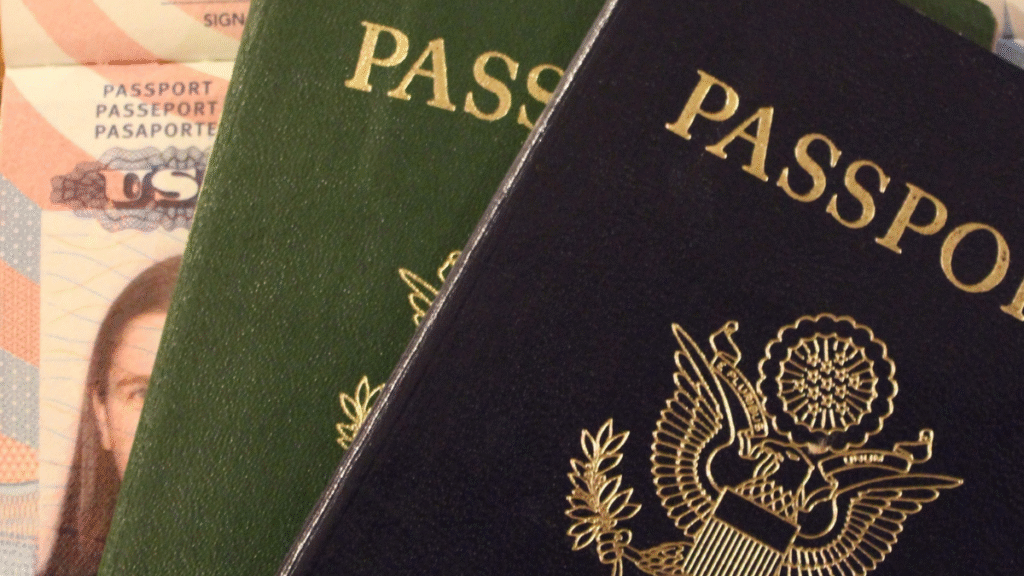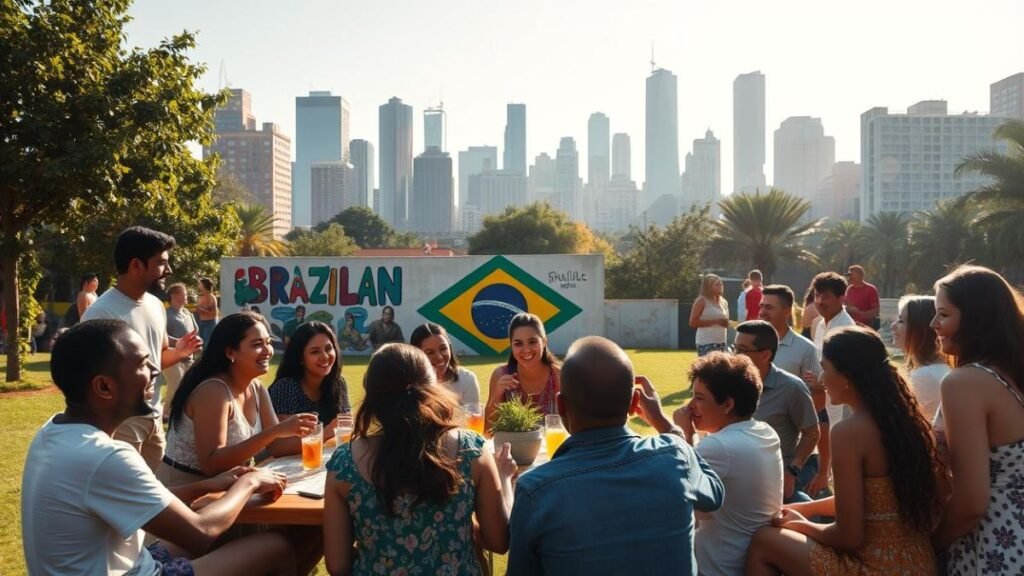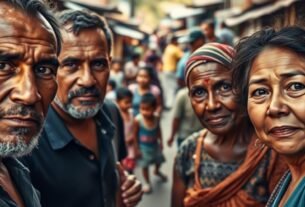Introduction
Have you ever wondered how Brazilian communities are shaping the cultural and economic fabric of the United States? If you’re curious how many Brazilians live in the US in 2025, you’re in good company — and the numbers may surprise you. Current estimates suggest that nearly 1 million Brazilians now call the US home, making it essential to understand the impact of this growing community on American society.

This article examines the trends and implications of Brazilian immigration, delving not only into the statistics but also into the rich contributions of this vibrant community to various aspects of American life. The influence of Brazilians extends beyond mere numbers; they bring with them a diverse array of traditions, culinary delights, and artistic expressions that enrich the nation’s cultural fabric.
From samba and bossa nova music that resonates in local festivals to Brazilian cuisine that has found a place in many American households, the cultural exchange is profound. Furthermore, the economic impact of this community cannot be overlooked, as many Brazilians have established successful businesses, contributing to job creation and innovation.
Their entrepreneurial spirit, combined with a strong sense of community, fosters a dynamic environment that benefits both immigrants and native-born citizens alike.
Key Takeaways
- Approximately 1 million Brazilians are expected to live in the US by 2025.
- This growing population is making a significant impact on American society.
- Understanding Brazilian immigration patterns reveals unique cultural contributions.
- Key cities are becoming major hubs for Brazilian communities.
- Brazilians in the US are influencing local economies and job markets.
How many Brazilians live in the US: an overview of the community
The Brazilian community in the US has experienced substantial growth over the past few decades, characterized by a rich tapestry of cultures and experiences. As one of the significant immigrant demographics, Brazilians have primarily settled in urban centers, with notable populations in cities such as Greater Boston, New York City, New Jersey, and Miami. These regions have become vital hubs for many seeking improved opportunities away from home.
Among Brazilian immigrants, a broad range of backgrounds is represented, encompassing diverse socioeconomic statuses and various educational levels. This diversity is reflected in the community’s contributions to the American workforce, with many Brazilians finding success in multiple sectors, from hospitality to technology.
This community’s dynamism not only enriches local cultures but also strengthens economic ties between Brazil and the United States, promoting a vibrant exchange of traditions and innovations. Understanding the complexities of the Brazilian community provides valuable insights into the broader immigrant landscape in the United States.
Historical Context of Brazilian Immigration to the US
The narrative of Brazilian immigration history reveals a complex tapestry woven with various migration waves and societal challenges. Over the years, the decision to emigrate has been driven by a myriad of factors, particularly during times of crisis, such as economic instability, political oppression, and social inequality.
Many Brazilians have sought better opportunities abroad, aiming for improved living conditions and access to education. Understanding these movements sheds light on the persistent trends that have shaped the Brazilian community in the United States, highlighting the resilience and adaptability of immigrants as they navigate their new environments and contribute to the diverse fabric of American society.
Timeline of Brazilian Migration Waves
Brazil has experienced several significant waves of migration. The initial surge began in the mid-1980s when the nation faced economic difficulties and political turmoil. This period marked the beginning of a notable increase in Brazilian immigration to the United States, with patterns that continued into the subsequent decades. The following timeline outlines some pivotal moments in Brazilian immigration history:
- Mid-1980s: Economic downturns prompt a surge in migration.
- 1990s: Continued emigration despite some economic recovery in Brazil.
- Early 2000s: An Increase in Brazilians Seeking Educational Opportunities Abroad.
- 2010s: The growth of Brazilian communities in urban U.S. areas.
- Present: Ongoing immigration in response to both opportunity and instability.
Reasons for Leaving Brazil in the 1980s
The reasons for emigration in the 1980s were deeply rooted in economic and social factors. Many Brazilians were driven to leave due to widespread poverty, high unemployment, and political instability. The economic landscape was characterized by hyperinflation and stagnant growth, which left countless families struggling to make ends meet.
Low wages and rising living costs exacerbated the situation, prompting families and individuals to seek better prospects abroad. In addition, the political climate was marked by a lack of democratic freedoms and civil unrest, leading many to feel unsafe and disenfranchised.
The convergence of these factors significantly contributed to the increased migration waves during this period. As families sought stability and opportunities for their children, the allure of the United States became increasingly strong, representing a chance for a fresh start and a more promising future.
Current Population Estimates of Brazilians in the US
Recent data highlight the growing Brazilian community in the United States. Current Brazilian population estimates suggest the presence of approximately 1 million Brazilians living in the country. With ongoing immigration trends and demographic shifts, projections for 2025 indicate that this number could rise to approximately 1.6 million. This anticipated increase reflects not only migration patterns but also the establishment of vibrant cultural hubs across various regions in the U.S.
Statistics and Projections for 2025
Understanding the landscape of Brazilian immigrants involves examining both current statistics and forward-looking projections. The following table summarizes the Brazilian population estimates along with significant projections for 2025.
| Year | Estimated Population |
|---|---|
| 2023 | 1,000,000 |
| 2025 | 1,600,000 |
Major Concentrations of Brazilians in US Cities
Throughout the United States, certain metropolitan areas show considerable concentrations of Brazilian communities. The most notable of these cities include:
- Boston is renowned for its vibrant Brazilian culture, which combines music, food, and festivals.
- New York is home to a diverse Brazilian population that has a significant influence on the local arts and gastronomy.
- Miami boasts a substantial Brazilian community that significantly contributes to the city’s diverse and multicultural landscape.
Demographics of Brazilian Immigrants
The Brazilian community in the United States showcases a rich and diverse demographic profile. This group includes a significant portion of young adults, particularly those between the ages of 21 to 34 years. Many of these immigrants originate from urban areas in Brazil, primarily coming from economically stable cities. Consequently, their immigrant backgrounds often reflect strong motivations for seeking better opportunities abroad.
Age Distribution and Backgrounds
The age distribution among Brazilian immigrants highlights a youthful demographic. Approximately 45% are aged between 21 and 34, while other age groups, such as those aged 35 to 54, contribute to the community’s overall diversity. This young population tends to be highly motivated, often pursuing higher education to enhance their career prospects.
Education Levels and Employment Opportunities
The education levels of Brazilian immigrants are notably high. Many individuals in Brazil possess degrees from universities, particularly in fields such as engineering, technology, and healthcare. This educational attainment plays a significant role in their success within the job market.
Employment opportunities vary widely, with a prevalent presence in sectors such as hospitality, services, and technology. These industries benefit from the diverse skill set offered by Brazilian immigrants, solidifying their place in the US economy.
How Many Brazilians Live in the US in 2025
The Brazilian populace in the United States continues to grow, revealing significant migration trends that reflect both challenges and opportunities for the communities involved. Understanding the nuances of these trends requires an analysis of current data, highlighting not only numbers but also the varied experiences of Brazilian communities across different regions.
In-depth Analysis of Migration Trends
Recent statistics indicate a steady increase in Brazilian immigrants within the US, with migration trends showing a movement from traditional urban hubs to suburban and rural areas. This shift often occurs as families prioritize stability and access to community resources.
The desire for better living conditions and educational opportunities plays a crucial role in these migratory patterns, encouraging Brazilians to explore regions that were once considered secondary destinations.
Regional Variations Among Brazilian Communities
Regional differences among Brazilian communities manifest in various forms, including cultural practices and community engagement. While larger cities like Miami and New York continue to serve as primary concentrations for Brazilians, smaller towns are becoming increasingly popular due to lower living costs and enhanced quality of life. The table below highlights notable cities with significant Brazilian populations, reflecting both established and emerging trends.
| City | Population Estimate | Recent Migration Trend |
|---|---|---|
| Miami, FL | 60,000 | Stable influx, concentration grows |
| Boston, MA | 30,000 | Increasing due to educational opportunities |
| Los Angeles, CA | 25,000 | High retention, strong professional networks |
| Dallas, TX | 15,000 | Growth in family relocations |
| East Coast Suburbs | Varies widely | Notable rise as families seek stability |
The Economic Impact of Brazilians in the US
The presence of Brazilians in the United States has created a notable economic impact that extends across various sectors. Their contributions to the job market and local economies are particularly significant, especially in the hospitality and tourism industries.
As this community grows, understanding their role becomes increasingly essential for gauging the broader economic landscape.
Contribution to Job Market and Local Economies
Brazilians play a vital role in addressing labor shortages across multiple sectors. They contribute significantly to service-oriented jobs, which are essential for local economies. Many Brazilians are found in positions that support community needs, from construction to healthcare.
Their involvement not only fills gaps in the labor market but also stimulates economic activity through spending and investment in local businesses.
Role in Hospitality and Tourism Sectors
In the realm of hospitality and tourism, Brazilians have made considerable waves. Their affinity for travel has had a positive impact on business in this sector. From restaurants to hotels, the influx of Brazilian tourists encourages growth, creating numerous job opportunities. The unique cultural experiences they seek often lead to a bustling tourism scene that benefits the local economies substantially.
| Sector | Job Contributions | Economic Impact ($ millions) |
|---|---|---|
| Hospitality | 25,000 jobs | 350 |
| Construction | 20,000 jobs | 280 |
| Healthcare | 15,000 jobs | 220 |
The economic impact of Brazilian tourism further illustrates the profound effect this community has on the U.S. economy. As they explore destinations and support local enterprises, their contributions lead to widespread benefits. A robust understanding of these dynamics provides a more comprehensive picture of what Brazilian immigrants contribute to the United States.
Cultural Assimilation of Brazilian Immigrants
The journey of cultural assimilation for Brazilian immigrants in the United States often varies significantly based on individual circumstances and community support. Challenges related to language barriers can present obstacles to successful integration into American society.
Despite these challenges, many Brazilian immigrants have developed effective integration strategies that facilitate their adaptation and help preserve their cultural identity.
Language Barriers: Challenges and Strategies
Language barriers remain a primary challenge for many Brazilian immigrants. Limited proficiency in English can hinder communication and create feelings of isolation. As a result, community organizations actively provide language classes and cultural workshops.
These resources not only help overcome language barriers but also promote cultural exchange and understanding. In many cases, immigrants report an improvement in confidence as they learn to communicate more effectively.
Integration into American Society
Successful integration strategies encompass various aspects of everyday life. Brazilian immigrants frequently participate in cultural activities, ranging from dance to culinary events, which helps foster connections within their communities.
Participation in these events encourages cultural assimilation while allowing individuals to share their heritage. Networking also plays a vital role; community gatherings create safe spaces for new immigrants to build relationships and strengthen their ties. Such interactions pave the way for better understanding and acceptance within American society.
| Integration Strategies | Benefits |
|---|---|
| Language Classes | Improved communication skills |
| Cultural Events | Strengthened community bonds |
| Networking Opportunities | Increased support system |
| Workshops | Enhanced cultural exchange |
Differences Among Brazilian Communities in the US
The Brazilian community in the United States exhibits substantial diversity, shaped by varying sizes and locations. These differences in the Brazilian community notably impact access to resources and social networks, allowing for varied experiences among individuals. Understanding these contrasts can illuminate the unique challenges and advantages faced by both large and small Brazilian communities.
Contrasts Between Large and Small Concentrations
Large Brazilian communities, particularly in cities such as Boston and Miami, often benefit from established support networks. These areas may provide education programs, cultural events, and comprehensive legal assistance tailored to the needs of Brazilians.
In contrast, small communities typically lack such extensive infrastructure, making it more difficult for individuals to access similar support resources. Nevertheless, small communities often foster close-knit relationships that create their own forms of emotional and logistical support.
Community Support and Resources Available
The availability of support resources diverges depending on community size. In larger communities, organizations like the Brazilian Consulate facilitate various services and connectivity among residents. Smaller communities may not have formal support structures, but they compensate with strong interpersonal connections, where community members often step up to aid one another.
This dynamic reflects a resilient spirit, demonstrating how communal bonds can thrive even in less populated settings.

| Community Size | Support Resources | Social Networks |
|---|---|---|
| Large Communities | Extensive resources such as legal aid, cultural programs | Wider connections, professional networking opportunities |
| Small Communities | Limited formal resources, stronger personal connections | Tighter-knit relationships, mutual assistance |
These insights into Brazilian community differences underscore the profound impact of community size on available resources and support. Regardless of the size, each community contributes to the rich tapestry of Brazilian culture in the US, adapting to its unique circumstances while preserving a strong sense of identity.
Brazilians’ Aspirations: Intentions and Expectations
Among Brazilian immigrants, motivations for moving to the United States reflect a range of aspirations and intentions. While some view their stay as a temporary opportunity to gain valuable experience, others actively pursue long-term residency. Understanding these immigrant aspirations offers insight into their future choices, as they balance the allure of life in the United States with the possibility of returning to Brazil.
Long-term Residence vs. Temporary Stays
The choice between long-term and temporary residency significantly influences the life paths of Brazilian immigrants. Those aiming for temporary stays often search for opportunities to enhance their skills and financial standing, hoping to return to Brazil enriched by their experiences.
In contrast, individuals seeking long-term residence focus on establishing roots, pursuing stability, and integrating fully into American society. This divergence in goals impacts their daily lives and future plans.
Future Opportunities in Brazil vs. the US
Evaluating future opportunities remains a critical consideration for many. In the United States, prospects for economic advancement, education, and career growth are among the factors that attract Brazilian immigrants. Conversely, some express a strong connection to their homeland and a desire to contribute to Brazil’s development.
Balancing these factors, immigrants often weigh the advantages of staying in the U.S. against the compelling reasons to return home, enriching their decision-making processes.
Impact of Recent Visa Trends on Brazilian Immigration
Visa trends have a significant influence on the dynamics of Brazilian immigration to the United States. Recent changes in visa policies have opened new pathways for many Brazilians, creating opportunities for travel and education. Understanding these trends reveals essential insights into the evolving landscape of immigration.
Statistics of Visas Issued in 2023
In 2023, the United States issued approximately 1.125 million visas to Brazilian citizens. This figure marks a notable rise compared to previous years, highlighting increased interest in U.S. opportunities. Factors contributing to this surge include a streamlined application process and shorter processing times. These enhancements have made securing visas more accessible to Brazil’s population.
Influence on Migration Rates Moving Forward
The recent visa trends have had a clear impact on migration rates among Brazilians. As more individuals successfully navigate the visa application process, there is a likelihood of higher migration figures in the coming years.
Brazilian immigration statistics indicate that the benefits of education and employment available in the U.S. continue to attract many. The long-term effects of these trends promise to shape both communities, facilitating cultural exchange and economic contributions.
How Brazilians Contribute to US Tourism
Brazilian tourism has seen a significant rise, making it a vital contributor to the U.S. economy. In 2024, Brazil positioned itself as the second-largest overseas market for U.S. tourism, attracting over 456,000 visitors. These travelers boost local economies through their substantial spending and support various sectors, particularly the hospitality industry.
Economic Benefits of Brazilian Tourists
The economic contributions of Brazilian tourists are substantial. On average, each traveler from Brazil spends about $4,000 per trip. This spending supports local businesses, including restaurants, hotels, and leisure activities, creating jobs and enhancing services that benefit the broader community. The influx of Brazilian tourists helps stimulate the economy in numerous regions across the United States.
Popular Destinations Among Brazilian Visitors
Several travel destinations in Brazil attract visitors due to their unique offerings. Prominent locations include:
- Orlando, Florida, is Renowned for its theme parks and family-friendly attractions.
- New York City, New York, is Famous for its iconic skyline and diverse cultural experiences.
- Los Angeles, California, is known for its entertainment industry and coastal beauty.
- Miami, Florida, is Popular for its vibrant nightlife and beautiful beaches.
These destinations play a key role in the growth of Brazilian tourism, offering experiences that resonate with Brazilian travelers. Supporting these travel destinations leads to lasting economic benefits and enhances the overall diversity of visitors to the United States.
Community Support Among Brazilians in the US
Community support is an essential aspect that influences the resilience and integration of Brazilian immigrants in the United States. Within this context, cultural organizations serve as crucial resources that offer assistance, foster connections, and create a sense of belonging among newcomers. These entities not only enhance social ties but also empower individuals by providing valuable information and networking opportunities.
Role of Cultural Organizations
Cultural organizations within the Brazilian community play a vital role in addressing various needs. They promote understanding and appreciation of Brazilian heritage through events, workshops, and educational programs. By encouraging participation in cultural events, these organizations effectively strengthen community bonds and facilitate a smoother transition for immigrants.
This sense of solidarity becomes invaluable as individuals seek to establish new roots in their adopted country. The organizational support also facilitates access to essential services, including job placement, legal advice, and language classes, enabling immigrants to navigate their new environment more easily.
Importance of Networking for New Immigrants
Networking is crucial for new immigrants seeking to establish connections and discover opportunities. Engaging with established networks can significantly ease the adaptation process. Many Brazilians rely on personal connections to discover job openings, secure housing, or simply gain emotional support during their transition.
Participation in community events facilitates these relationships and expands professional networks, which ultimately fosters a spirit of collaboration and mutual assistance.
For a deeper understanding of the Brazilian community and its dynamics, interested individuals can explore further at Brazilian Americans.

Perceptions of Brazilians Among Americans
Addressing societal perceptions is a crucial step toward fostering positive interactions between Brazilians and Americans. While cultural misunderstandings can create barriers, various initiatives aim to bridge these gaps, promoting better community relationships. Engaging in community outreach and participating in local cultural festivals are effective ways to enhance mutual understanding and appreciation.
Overcoming Stereotypes and Misunderstandings
One significant challenge involves overcoming stereotypes that can misrepresent the Brazilian community. Many Americans lack an accurate understanding of Brazilian culture, resulting in common misconceptions.
Brazilian individuals often work to combat these stereotypes by showcasing their diverse traditions, cuisines, and contributions to society. Participating in events that highlight Brazilian culture plays a vital role in reshaping these misconceptions. These interactions not only create shared experiences but also foster friendships that contribute to healthier community relationships.
Building Positive Relationships with Local Communities
Building strong community relationships requires active engagement from both sides. Brazilian immigrants often form alliances with local organizations, which facilitates their involvement in civic activities. By collaborating with various cultural groups, Brazilians actively contribute to fostering positive societal perceptions, promoting inclusivity and unity.
This collaborative spirit encourages understanding and helps reduce cultural misunderstandings. Several reports, including those from the Pew Research Center, emphasize the importance of these community initiatives in promoting more harmonious relationships among diverse populations.
The Future of Brazilian Immigration to the US
The outlook for Brazilian immigration to the United States is encouraging, driven by various factors that will influence migration patterns in the years ahead. Economic developments in Brazil, potential policy changes in the United States, and evolving global dynamics are central to predictive analysis of future trends in immigration. Understanding these elements provides valuable insights into how the flow of Brazilian migrants may shift.
Projected Trends for the Next Decade
As we look forward to the next decade, several trends emerge regarding Brazilian immigration. The growth in remote work opportunities allows some individuals to relocate while maintaining ties to Brazilian employers. A rise in educational pursuits, especially in health and technology fields, encourages younger generations to seek opportunities abroad. Government policies, notably visa regulations and residency options, will play a critical role in shaping these waves of migration.
Factors Influencing Migration Patterns
Economic conditions in Brazil serve as a significant driver for migration. Many Brazilians continue to seek better job prospects, particularly in the United States’ robust economy. Additionally, social networks established by previous immigrants often facilitate the integration of new arrivals, encouraging family reunification and settlement. Furthermore, global crises, such as environmental challenges or political instability, may influence future immigration flows and decisions.
Challenges Facing Brazilian Immigrants in the US
The journey of Brazilian immigrants often encounters numerous obstacles. Legal issues and cultural barriers significantly impact their ability to thrive in their new environment. Understanding these challenges is crucial for fostering a more supportive atmosphere for the Brazilian community.
Legal and Status Issues
Legal hurdles pose significant challenges for many Brazilian immigrants. The complex web of immigration laws creates confusion, leaving individuals uncertain about their status.
Many face the threat of deportation while trying to navigate the often arduous process of obtaining necessary documentation. The fear of legal repercussions can prevent immigrants from seeking essential services, including healthcare and employment opportunities.
Cultural and Language Barriers
Cultural barriers add another layer of challenge for Brazilian immigrants. Adapting to unfamiliar customs and communication styles can be daunting. Language barriers, in particular, hinder social interaction and integration into American communities.
Without proficiency in English, accessing job opportunities, education, and social services becomes increasingly difficult. Overcoming these cultural obstacles requires support from local organizations and the broader community.
Conclusion
This article offers a comprehensive overview of Brazilian immigration, highlighting that a substantial and vibrant community now resides in the United States. With estimates projecting continuous growth, the Brazilian community is making significant strides in various sectors, including hospitality, tourism, and local economies. Their cultural contributions have added richness to the American mosaic, while they have faced unique challenges, including legal status issues and integration hurdles.
The impact of the Brazilian community on American society is profound, as evident in their significant economic contributions and rich cultural exchange. As the landscape continues to evolve, the future outlook remains optimistic, suggesting that this diverse group will further enhance its role within American society. Addressing both opportunities and challenges, the Brazilian immigrant experience serves as a testament to resilience and the strength of community.
In summary, Brazilian immigration has not only reshaped individual lives but has also woven new narratives into the fabric of the United States. As we look ahead, the potential for growth and integration stands resilient, promising a future where Brazilians will continue to thrive and contribute meaningfully to their adopted homeland. Learn more about Hospitality.
FAQ
How many Brazilians currently reside in the United States?
Current estimates indicate that approximately 1 million Brazilians reside in the U.S., with projections suggesting this number could increase to 1.6 million by 2025.
What are the major cities where Brazilian immigrants are concentrated?
Major concentrations of Brazilians are found in Greater Boston, New York City, New Jersey, and Miami, which serve as hubs for immigrants seeking better opportunities.
What motivated Brazilian immigration to the U.S. during the 1980s?
Brazilian immigration began to increase significantly in the mid-1980s due to economic downturns and political instability in Brazil, prompting many to leave the country in search of better living conditions.
What industries do Brazilian immigrants typically work in?
Many Brazilian immigrants find employment in sectors such as hospitality, services, and technology, reflecting a diverse range of skills and educational backgrounds.
What challenges do Brazilian immigrants encounter in the United States?
Brazilian immigrants frequently face challenges related to their legal status, cultural integration, and language barriers, which can hinder their job prospects and community involvement.
How do Brazilian cultural organizations support immigrants?
Cultural organizations play a vital role by providing resources, networking opportunities, and fostering social connections, which are essential for new immigrants navigating life in the U.S.
What role does Brazilian tourism play in the U.S. economy?
In 2024, Brazil became the second-largest overseas market for U.S. tourism, with Brazilian tourists contributing approximately $4,000 per trip, thereby significantly supporting local economies.
What factors influence the future of Brazilian immigration to the U.S.?
The future of Brazilian immigration depends on several factors, including economic conditions in Brazil, U.S. policies, and evolving opportunities, which will continue to influence migration patterns.
How do Brazilian communities differ across the U.S.?
While larger concentrations, such as in Boston and Miami, have more established networks, smaller communities tend to foster close-knit social networks that provide critical support for immigrants.
What are the common aspirations among Brazilian immigrants in the United States?
Brazilians have varied motivations for migrating; some view their stay as temporary to gain experience, while others aim for permanent residency in pursuit of stability and economic advancement.




